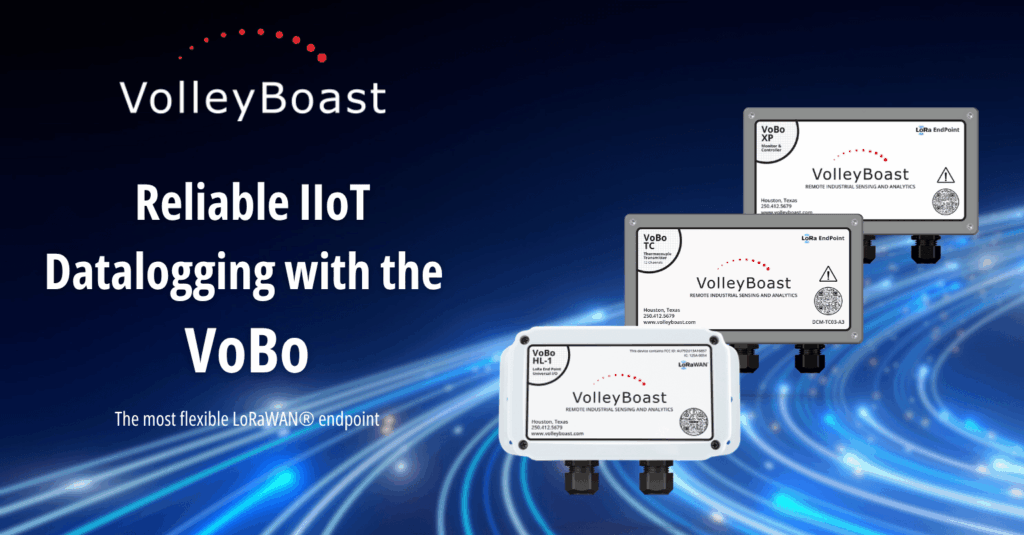Ensuring data is captured and preserved is essential in industrial and remote monitoring applications. Whether you’re managing off-grid weather stations, monitoring mining infrastructure, or overseeing agricultural irrigation systems, there are times when communication isn’t possible. This is where the Volley Boast VoBo excels, not just as a LoRaWAN® endpoint, but as a resilient, standalone data logger that protects your data, so it’s available when you need it.
In this article, we explore how the VoBo serves as a high-reliability data logger, both in network-connected and offline environments, and how its architecture, hardware, and storage features make it an ideal solution for sensor monitoring.
Always Logging: Even When the Network Isn’t
The VoBo is always logging data. When online and connected to a LoRaWAN® network, and offline, the VoBo captures and stores sensor readings into its onboard flash memory. Once the memory has ~5000 payloads in storage, older records are overwritten as new payloads arrive. This circular buffer design ensures that no manual memory management is needed, and the device never stops collecting data due to storage limits.
In online mode, the VoBo collects and transmits data via LoRaWAN® according to its schedule. Even as data is sent, it is also stored locally. If network communication is interrupted, the VoBo continues to log data without interruption. When the connection resumes, only the current payload is transmitted. Any payloads not received by the network can be collected locally.
In offline mode, the VoBo doesn’t attempt to join a LoRaWAN® network. Instead, it operates on a normal wake-sleep cycle, collecting data from the connected sensors and logging the data into memory, but does not transmit the data. This mode is ideal for areas without LoRaWAN® coverage or when transmission isn’t needed, but reliable local data collection is.
Hardware Designed for Logging and Longevity
The VoBo is built from the ground up for rugged, long-term industrial deployment. Key hardware features include:
- Battery-powered design. With multi-year battery life depending on use, the VoBo continues to operate even during power outages.
- Onboard flash memory. With 16MB of non-volatile memory, the VoBo can store thousands of sensor payloads.
- Industrial enclosures. VoBo’s enclosure is waterproof, rugged, and field-ready.
- Flexible sensor support. VoBo is compatible with analog, digital, and serial Modbus sensors, and can power them if needed.
This combination enables the VoBo to function independently as a data logger even in the harshest environments or where external power is unreliable or unavailable.
No Setup Needed: It Just Works
The VoBo doesn’t require any special configuration to enable logging; it begins storing data automatically as soon as it starts receiving sensor input. There’s no need to turn the feature on or manage the VoBo’s settings. Data logging is built in and always active.
Once storage reaches capacity, the VoBo automatically overwrites the oldest entries. This simplifies storage management and gives the user months to download older data.
Local Data Retrieval: Easy and Accessible
The VoBo supports local data recovery. Using a serial connection via the VoBo configuration cable and the VoBoConfig tool, users can extract data directly with a laptop or computer. The exported data is available in CSV format, ready for analysis or archiving.
This local access allows teams to deploy VoBos in isolated locations and return later to collect data without worrying about data gaps or loss.
Bridging Other Devices to LoRaWAN®
Beyond its role as a direct sensor interface, the VoBo can serve as a bridge to other data loggers. For example, the VoBo GP-1/HL-1 model interfaces with any sensor connected to a Campbell Scientific datalogger via Modbus RTU and relays that data over LoRaWAN®. This extends data collection and transmission to legacy or non-LoRaWAN® systems, enabling hybrid deployments where legacy and new hardware coexist.
Read more in the article The VoBo GP-1/HL-1: Reading and Transmitting Vibrating Wire Sensor Data from Dataloggers in the VB blog.
Performing Functions on the Logged Data
While the data is logged in the VoBo’s memory, you can have the VoBo perform functions like changing the cycle time based on input data. With VoBoAnalytics, it’s possible to configure analytic summaries such as minimum, maximum, and average value of input data, including Modbus. The results can be transmitted in addition to, or in place of, raw sensor data.
When the Lights Go Out, Your Data Stays Safe
One of the VoBo’s most valuable features is its resilience during power failures and network outages. Because it is battery-powered and logs data locally, the VoBo ensures that sensor data continues to be collected and preserved even without a network or external power. Once systems are restored, transmission works as normal. You can retrieve the stored data anytime.
Conclusion: A Smarter Way to Capture Every Reading
Lost data isn’t just inconvenient in remote and industrial environments; it’s costly. The VoBo solves this problem by combining data logging with LoRaWAN® connectivity. Whether you’re monitoring field conditions, regulatory compliance, or your infrastructure’s health, you can rely on the VoBo to capture and protect every data reading.
Log your data with confidence, even when the network isn’t connected. The VoBo is your reliable go-to data logger for rugged, low-power applications.
Purchase a VoBo on our website. Corporate accounts and integrators: please contact us at info@volleyboast.com or +1 250-412-5679.

